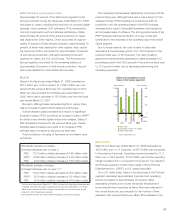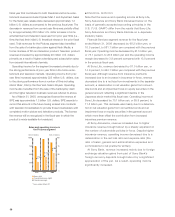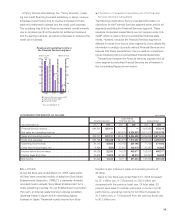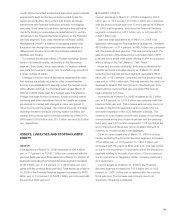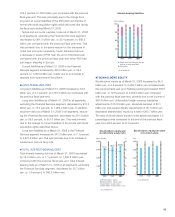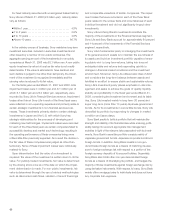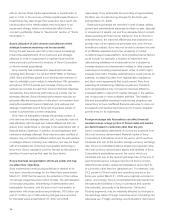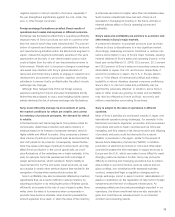Sony 2008 Annual Report Download - page 68
Download and view the complete annual report
Please find page 68 of the 2008 Sony annual report below. You can navigate through the pages in the report by either clicking on the pages listed below, or by using the keyword search tool below to find specific information within the annual report.66
For fixed maturity securities with unrecognized losses held by
Sony Life as of March 31, 2008 (2.6 billion yen), maturity dates
vary as follows:
¥■
¥Within 1 year. . . . . . . . . . . . . . . . . . . . . . . . . . . . . . 4.8%
¥■
¥1 to 5 years .............................. 3.9%
¥■
¥5 to 10 years ............................. 4.6%
¥■
¥Above 10 years. . . . . . . . . . . . . . . . . . . . . . . . . . . . 86.7%
In the ordinary course of business, Sony maintains long-term
investment securities, included in securities investments and
other issued by a number of non-public companies. The
aggregate carrying amount of the investments in non-public
companies at March 31, 2008 was 62.1 billion yen. A non-public
equity investment is valued at cost as fair value is not readily
determinable. If the value is estimated to have declined and
such decline is judged to be other-than-temporary, the impair-
ment of the investment is recognized immediately and the
carrying value is reduced to its fair value.
For the fiscal years ended March 31, 2007 and 2008, total
impairment losses were 7.4 billion yen and 37.1 billion yen of
which 6.1 billion yen and 24.0 billion yen, respectively, were
recorded by Sony Life in Financial Services revenue. Impairment
losses other than at Sony Life in each of the three fiscal years
were reflected in non-operating expenses and primarily relate to
certain strategic investments in non-financial services busi-
nesses. These investments primarily relate to certain strategic
investments in Japan and the U.S. with which Sony has
strategic relationships for the purposes of developing and
marketing new technologies. Impairment losses were recorded
for each of the three fiscal years as certain companies failed to
successfully develop and market such technology, resulting in
the operating performance of these companies being more
unfavorable than previously expected. As a result the decline in
the fair value of these companies was judged as other-than-
temporary. None of these impairment losses were individually
material to Sony.
Upon determination that the value of an investment is
impaired, the value of the investment is written down to its fair
value. For publicly traded investments, fair value is determined
by the closing stock price as of the date on which the impair-
ment determination is made. For non-public investments, fair
value is determined through the use of various methodologies
such as discounted cash flows, valuation of recent financings
and comparable valuations of similar companies. The impair-
ment losses that were recorded in each of the three fiscal
years related to the unique facts and circumstances of each
individual investment and did not significantly impact other
investments.
Sony Life and Sony Bank’s investments constitute the
majority of the investments in the Financial Services segment.
Sony Life and Sony Bank account for approximately 84 percent
and 14 percent of the investments of the Financial Services
segment, respectively.
Sony Life’s fundamental policy in managing the investments
of its general account assets is to maintain the soundness of
its assets and build an investment portfolio capable of ensur-
ing stable mid- to long-term returns, taking into account
anticipated risks and returns and responding quickly to
changes in financial market conditions and the investment
environment. Moreover, Sony Life utilizes basic idea of ALM
and considers the long-term balance between assets and
liabilities in an effort to ensure stable and sustainable returns.
Sony Life’s investment policy places emphasis on risk man-
agement and seeks to achieve the goals of quality, liquidity,
stability and profitability. In the fiscal year ended March 31,
2008, considering the investment environment and its liabili-
ties, Sony Life invested mainly in long-term (10 years) and
super long-term (more than 10 years) Japanese government
bonds. As for its investments in convertible bonds, Sony Life
diversified its portfolio by responding to changes in market
condition and issue status.
Sony Bank seeks to build a portfolio that will maintain the
strength and stability of its financial base while ensuring profit-
ability, taking into account appropriate risk management
activities in light of the relevant risks associated with its invest-
ments. Sony Bank’s securities portfolio consists mainly of
Japanese government bonds, Japanese corporate bonds and
foreign bonds. In addition, Sony Bank invests in non-yen-
denominated foreign bonds as a means of matching its expo-
sure to foreign exchange risk with respect to a portion of the
foreign currency deposits of its account holders. Separately,
Sony Bank also holds other non-yen-denominated foreign
bonds as a means of diversifying its portfolio, and hedges the
majority of those investments against foreign exchange risk by
using derivative instruments. With respect to loans, Sony Bank
mainly offers mortgage loans to individuals and does not have
any corporate loan exposure.



